
...gathering knowledge for the arts.




Author's Statement and Introduction
Trapped In Convert is the first electroacoustic piece that I heard (in 1993) that was made solely with computer and that for me was approachable art because it is a composition that has phrases, rhythm, continuity, happy sounds and even melancholy, and yet every instrument could sing by itself as in a miniature vignette. For these reasons I de-composed the code, section by section, instrument by instrument, so that I could compile the code to hear anything that my curiosity asked for. The purpose of presenting this analysis of Trapped In Convert in the methodical way it is presented here is for composers of computer music, student or otherwise, to see a way (if not the way) that in order for us to make comments about a composition, we should learn all that we are interested in (and even more) about that composition. And, this ultimately will serve to improve our own composition writings. When we look at the code of Trapped In Convert for the first time we see the orchestra and score code that is written in a text-based manner, which could be read almost like normal text. Therefore we have approximately thirteen pages of text-based code that most composers as well as most proficient programmers with a love and a keen interest for art and music can understand quite completely. However, when we read a music analysis we often come upon many particular discoveries, some apparent, some subtle, all of which are important to the analyst because they give answers as to why the composer composed the music in such a way. That is the purpose for which the composer consciously, or even unconsciously, writes at a particular point for some creative reason to elicit an aesthetic response from the listener....


Introduction
Reteplas is a composition composed exclusively for performance by a computer and a synthesis program Csound. It is based on a Latin text from the Vulgate Bible: Psalm 39:12-13, Psalm 40:1-3, and Psalm 150 of the King James Version. The intent was to translate the Latin words of the text and to generate a melodic sequence by dividing the octave into 26 microtones, one for each letter in the alphabet. It was also intended that the composition be performed with a computer and not with acoustic instruments because of the microtonality application. This provided flexibility for experimenting with complex rhythms and tempo application. The main tool used to compose Reteplas was Csound, a computer synthesis parameter-oriented program, which allows music elements to be specified mathematically. This wider scope of choice in musical ingredients was the main motivation in composing for a computer, rather than to simulate live musicians, and Reteplas was intended as a vehicle in which to explore this flexibility.
Echoes From Mir was written with the intent to create a composition with computer that would produce a virtual ambient where the sound would move around the audience in three dimension so to perceive it as sound transmitted from Mir the space station in orbit. The composition has percussive sounds, metal pipes together with many other metallic sounding instruments creating a homogeneous mixture of sounds. Virtual human voices in microtonality sing a choir-like romantic melody... the hope that this is what is out there in the outer limits of planet Earth.
The compositions were entirely composed using the Csound program.
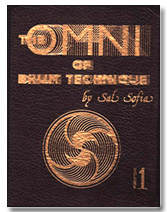

Introduction
Because I have been a student myself for many years and have studied under some of the greats in music teaching and performing, I pride myself in knowing and understanding the desires and frustrations of music students.
This book imparts an advanced technique of independence, improvisation and coordination that serves to mold today's well-rounded drummer into tomorrow's innovator. This, you may be saying, is no different than many other music books; however, this book is a pioneer in its teaching method.
First, this book deals with the student on an individual rather than on a collective basis ever mindful that each student has his own potential, skill and ideas. Due to the composition of the patterns the student need not begin with the rudiments and then build up to his potential but begin using his potential, thus developing his own ideas immediately. Secondly, the rudiments depart from its tradition of snare drum march music. Instead, they are applied to the drum set as a whole, providing four-way coordination around the drums insuring independence and creativity--thereby, giving new depth and capacity to today's contemporary music. In addition, though Omnitechnique is written in four-four time and cut time, it is not constricting to only this meter. This book's design enables the student to play in all kinds of meters through a superimposition of rhythm and counter- rhythms, meter within meter, within the framework of four. Lastly, Omnitechnique offers exercises that are practical and up to date. Since I did not want this book to be labeled in relation to any particular style, thereby constricting its usage, the different styles of music are not outrightly mentioned. I have incorporated all the different modes of music within the study patterns themselves and if the student applies himself as suggested in each chapter, he will be playing not only today's most modern sounds in fusion, funk, jazz, latin, rock, country, et cetera but drawing from his own creative reservoir, tomorrow's future sounds. The Omni of drum Technique is all that its title suggests--a total unrestriction of drum technique. This book truly broadens a drummer's scope, totally involving him within the music and from yesterday's time keeper evolves today's own drummer with a personal sound that will mark him as an innovator.


Introduction
Because modern music is so developed, the knowledge of musical drum set study is a must. Without adequate foundation and training this type of drum set analysis and playing can be a very difficult, frustrating chore rather than the enjoyable, soul-expressing art it has evolved to be.
TRAPS, A Rudimentary Approach was written to impart the full musical significance of the rudiments to the student drummer. What they are, how they originate, their total capacity is completely developed musically. They are thought of in a different way and studied to be recognized out of their traditional context. They are not considered as just a rhythm which to keep marching time on the snare drum but through a gradual breaking down and a natural recycling, the rhythm is displaced on the entire trap set to provide very artfully for articulate drum set expression.
TRAPS offers a vocabulary builder of modern drum sounds for all styles and demonstrates how the drummer can create sounds that reflect his own personality, style and intellect. As the twenty-six letters of the alphabet form the words, phrases and sentences with which we verbally communicate, the twenty-six American rudiments, as exemplified in TRAPS, A Rudimentary Approach, form the beats, any style through your drums.
Along with the gradual rudimental development is the gradual improvement of the techniques used to play what we are learning. Solid time keeping through metronome monitoring, ear training to the new sounds created, linear coordination through independent four-limb playing are all methodically developed. Reading drum set music is systematically demonstrated and explained, as well as the basic fundamentals of drum set playing are defined.
This book truly lays the solid musical foundation necessary for traps set players to not only learn and cope, but, set the trend in drum set playing.
I sincerely hope that you profit from the stimuli offered here in TRAPS.
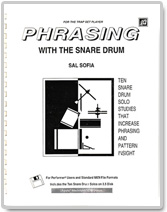

Introduction
The ten snare drum solo studies presented in this book are designed to increase the phraseology of the trap set player while sharpening site reading and recognition of certain patterns. In essence, by becoming aware of and identifying those sounds you have heard thousands of times from your favorite drummer, and from other instrumentalists as well, you will learn to see "phrasing", not just isolated, single notes, but groups of notes that, in turn, are grouped into motives and thematic phrases.
The importance of phrasing in music cannot be stressed enough and it's usage is not limited to the drummer only. Phrasing is the language of all musicians that allows them to communicate with one another in a playing situation. Expressive, eloquent and articulate phrasing is the goal of every improviser, composer and teacher working in this area.
As preparation for these ten solo studies, it is helpful to analyze a few measures of the phrases, calling attention to such organizing principles and devices, such as repetition of ideas, the "set up" or "lead in" to the phrase, the "turn around", and so on.
Here are some additional pointers that will help as you study the phrasing material in this book:
In conclusion, phrasing is an acquired skill that demands practice and concentration, like any other subject in music. You should give your full attention to recognizing the phrases when practicing, practice phrasing regularly and listen to how other musicians apply phrasing in their solos and group performances...
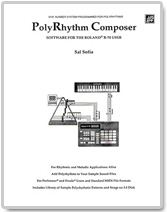

Introduction
The PolyRhythm Composer (PRC) Software is an architectonic file of polyrhythms, from basic patterns to composed song applications.
The number system used to program the PRC software was designed for use with the Roland R-70 Human Rhythm Composer (but not exclusively limited to the R-70), and acts like an interface to unlock the metronome markings barrier for composers to write and hear polyrhythms with R-70. In addition, by applying the Table of Relative Metronome Markings for Polyrhythms, the PRC software allows the R-70 user to virtually customize their own polyrhythm patterns or compositions in a potentially unlimited number of file formats to call upon when the need for polyrhythm composition is required.


P.I. NOTES
Many people have asked why this magazine -- and in particular, its audio format -- came about.
Because I have been a clinician for the past four years and have sponsored tours throughout Europe and Canada, I have been privileged to meet many percussionists, teachers and performers and especially, aspiring students who came together with one serious objective and that was, to learn more about percussion. Since I was not known as a player, they always asked the same question, "Can you play what you write in your books?" and another favorite was, "Through what kind of technique does Steve or Vinnie or Billy, et cetera play this or that?" Other professionals, authors and teachers and clinicians, also met with the same questions. After some serious thought, I rejected the idea of writing another book with an audio cassette because there are many such books that "speculate" on other famous players' performing. I thought a more natural and pure way to communicate with percussionists was to gather the performers and teachers that "are" the percussion specialists from all styles, for all percussion instruments and cultures, to all write in one book and to play what they write on cassette. And, in addition, to include in this book interviews with deserving personages of percussion to bring to light their philosophy, their message, their mission in the music business and thus help aspiring students to not only be aware of these personages' feelings but to also grow through their experience which they are all so eager to share.
And just as good artists have spent time in studying to develop their quality, the industry has also so to come about. People that came, come or will come out with a different product are people that are used to doing something well and who are not selfish because they care about the next percussionist. They are not just business people. They are wrapped up in their art -- to make a good product for the betterment of percussion and percussionist. Percussioner International wants to show these industrial people for what they are and for the art that does go into every good percussion instrument made.
The name of th magazine is Percussioner International Audio Magazine and P.I. will live up to that second word, international, and try to make percussionists aware of music products, instruments, schools, whatever and wherever from even the remotest place. And, it is P.I.'s desire to give as much a variety of music, styles and instruments as possible to the world of percussion.
Percussioner International thanks God that the contributing writers, the featured artists and the caring industrial people have open minds (after all, that is what this profession is all about) and helped to bring about this first issue. Any idea no matter how great, without people's help would be very difficult to succeed.
Percussioner International has many messages within its pages but one hope above all from its editor and founder is that inspiration is derived from its writings and that percussionist use this magazine to the best of their knowledge so that even more ideas will develop.
And now I will let Percussioner International speak for itself (and it really does!).
-- Sal Sofia
Percussioner International Vol 1, Number 1. June 1984. P.I. INTERVIEWS Steve Gadd, Ralph MacDonald, Dave Samuels, John Beck, Trichy Sankaran, Sabian, Calato, Slingerland, Eastman School of Music. P.I. GUEST SPEAKER Eddie Gomez. P.I. SEMINARS John Beck, John Bergamo, Gary Chaffee, Jim Chapin, Swapan Chaudhuri, Anthony Cirone, Justin DiCioccio, David Friedman, Norbert Goldberg, Emil Richards, Kobla & Alfred Ladzekpo, David Garibaldi, Ralph Humphrey, Tangerine k. Hill, David Samuels, Trichy Sankaran, Sal Sofia. P.I. GIVING IT TO YOU STRAIGHT Ralph LaFemina.
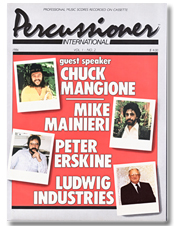

P.I. NOTES
One year and half ago the premier issue of Percussioner International was issued with the sincere intent to really satisfy the educational needs of the art and the business. The product was accepted very well from everyone -- subscribers, store owners, musicians, schools and the industry -- as you can see in "Notes to P.I.". However, we ran into difficulties which prevented us from presenting the magazine and cassette as professionally and regularly as promised. I truly thank you all for your patience, dedication and generosity.
There have been some changes for the betterment of our readers. The magazine has been expertly put together to present a clearer picture of the seminars. An imprinted cassette will indicate those seminars played on the actual cassette. The quality of the tape recording has been improved with regard to sound as well as the artists' presentation. The exercise seminars are more concise and direct. And every issue will include a song with complete music scores so that the percussioner can see, hear, of course, and learn from what is going on the other side of his instrument, or as I entitled the seminar, "The Other Side of the Track". In addition, these scores for "Sleepy Hollow", thoroughly explained by Ed Saindon and played by his group, Spectrum, are printed the way the author wrote it because when we perform in a live situation the music is not typed by machine or computer. In this way, the student can begin to see what it's all about, now.
And just as we have the obligation to inform on a good educational level, we feel we are also obliged to relate what the professionals of music really have to say. We tell you as it is, without fancy words and flowers that frustrate rather than educate and only makes this profession more difficult than what it is. We want to encourage the student to feel good when they read an article or hear the lessons on the cassette, to benefit as much as they can from the experience of the pros, so that their minds will be open to all styles of music and grow.
There is a wide spectrum of reward offered in these pages no matter what your position -- student, teacher or player. There will be more effective teaching methods because instructors from all over can keep almost directly in touch through the cassette "with a percussionist that they may not have had the opportunity to hear perform before"; " to hear that book in practice that they heard people talk about"; " to hear how a brand new instrument sounds rather than just see it in a picture". So, whether you are a student, teacher, enthusiastic listener or a parent, Percussioner International offers you something interesting and informative, as it as.
And though the price has been increased from $7.50 to $9.95, as Larry Londin or Bob Moses states in their letters there is so much written and recorded educational material of the best quality. Because I personally care what you are reading and listening to, I would not publish something I would not buy myself. So, please remember that I did not jump on the band wagon of magazine publishing to make myself rich. I did this with the conviction that music is an art that should be shared and everyone can play a part.
I would like to thank all the people that made this issue possible because I know they are the true artist in the real sense of the word. I would like to dedicate this issue to all of you. God bless you.
-- Sal Sofia
Percussioner International Vol 1, Number 2. P.I. INTERVIEWS Peter Erskine, Mike Mainieri, Chuck Mangione, Bill Ludwig. P.I. GUEST SPEAKER Chuck Mangione. P.I. SEMINARS John Beck, John Bergamo, Gary Chaffee, Swapan Chaudhuri, Dave Mancini, David Friedman, Norbert Goldberg, Emil Richards, Kobla Ladzekpo and Alan Eder, Ralph Humphrey, Bernard Purdie, Trichy Sankaran, Ward Durrett. P.I. GIVING IT TO YOU STRAIGHT Ralph LaFemina. P.I. THIRTEEN QUESTIONS Cheech Iero.
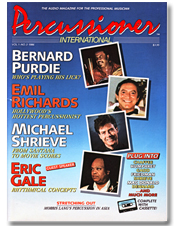

P.I. NOTES
I believe that now all that Percussioner International claims to be -- an educational tool that imparts the true meaning of the art form of music -- is finally being recognized as so by its public. Our two issues have acquired a world-wide mass distribution contract with one of the eight major distributors in the United States, an accomplishment that has still yet to be achieved by any other percussion magazine! Now Percussioner International can be purchased in Barnes and Noble, Walden's, B. D'Alton's, at news stands, and in convenience stores. The results of our wide-spread availability will be considerably felt by many -- our readers will naturally have the opportunity to purchase PI regularly and conveniently , the industry and private advertisers will have the benefit of a large progressive and educated audience, and the art and profession of percussion itself will regenerate to provide better learning methods and musicians. Already the serious percussion educator/musician recognizes the pedagogic value of PI's seminars and the truth and the importance of the informative interviews.
As Percussioner International offers so much within its covers, we are in constant search for a more comprehensive format that is alive and interesting. PI Highlights is featured on a double page spread that presents a picturesque overview of what is offered in the issue; the interviews are displayed with an uniqueness and character significant of the artist being discussed; the seminars are totally functional but always dynamic (we thought it important to have each bar or score of music to follow its own introductory text) and on each opening title page is a picture of a cassette with a seminar's respective position; "OFF THE PRESS" includes editorial, news from the industry, percussion books and records, the classifieds, and provides as well percussion fun with the puzzles.
"13 QUESTIONS" by Bernard Purdie reflects the opinions of great artists such as John Abecrombie,Steve Swallow, Gary Burton, and others as they frankly discuss the problems and topics of the music business that are sometimes "swept under the carpet". And, as with the "Guest Speaker" column, in this issue we learn from noted guitarist Eric Gale, percussioners can well benefit from the experience of musicians who are not percussionists. A new column, "Stretching Out", will enlighten you with the unusual. For its debut, Prof. Morris Lang stretches out to the East and shares new insights in an article exclusively written and recorded for PI readers. There are four full songs this issue: most notable Eric Gale's "On The Other side of the Track" with Bob James compositions featuring the cream of musicians, and one of Michael Shrieve's electronic masterpieces.
This issue, as every issue of Percussioner International, is packed with information that brings you closer to the truth of music in general and specifically, of percussion. Our plans for PI future issues are no less exciting, as we seriously try to fulfill our obligation to percussion and our readers.
-- Sal Sofia
Percussioner International Vol 1, Number 3. P.I. INTERVIEWS Bernard Purdie, Emil Richards, Michael Shrieve, Eric Gale. P.I. GUEST SPEAKER Eric Gale. P.I. SEMINARS John Beck, John Bergamo, Gary Chaffee, Dave Mancini, David Friedman, Kenwood Dennard, Kobla Ladzekpo and Alan Eder, Ralph Humphrey, Ray Spiegel, Bernard Purdie, Ed Saindon, Michael Shrieve. P.I. GIVING IT TO YOU STRAIGHT Ralph LaFemina. P.I. ON THE OTHER SIDE OF THE TRACK Eric Gale. P.I. THIRTEEN QUESTIONS Bernard Purdie.P.I. STRETCHING OUT Morris Lang
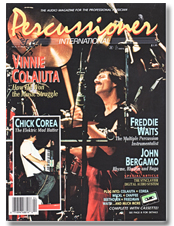

P.I. NOTES
It seems that what people remember about such artistic heros as Leonardo Da Vinci, Michelangelo Buonarroti, Ludwig van Beethoven, or Giuseppe Verdi is the struggle and sacrifice these artists lived for what they believed. Of course the changing times as years pass have promoted progress but just because you don't live as a beggar, or you are not considered an eccentric by your peers, have the problems disappeared? Or, instead, have they been masked and renamed? Now, musicians still live from commission to commission but for some reason it is like a poisonous disease to say that you are not working, or try to do things your own way. Why is so terrible? What makes today different from yesterday? Have you ever stopped to get off the peer pressure merry-go-round to find out the answer?
What all the above artists had in common was, of course, extreme talent, but above all else, they had no use for peer pressure, society's dictates, and industrial politics in the true sense of the artful living. Revolutionary. Yes. But, listen to the rut we artists have fallen into. Today, the industry's game plan is to pump media money into the top forty commercial bands and society buys it because that is what is crammed down their throats. Young musicians, and some older ones too, themselves think this is what's happening and frown upon those who are not a part of it. But, what is really happening is a non-productive music extravaganza, be it a record, an instrument or a band, that is trendy, transitory and temporary because the true musicians' statements since The Beatles, and the industry's products are in today and out tomorrow.
The answer as always lies with the musicians themselves.
Few musicians with a strong musical background have successfully gone knowledgeably commercial (approachable) to became recognized by the masses and yet they have maintained their artistry to produce a product that has longevity. Progress is on our side. Let's make it work. Becoming musically educated and aspiring for better produces art that will thrive forever as does Da Vinci, Michelangelo's, The Beatles'.
-- Sal Sofia
Percussioner International Vol1, Number 4. P.I. INTERVIEWS Vinnie Colaiuta, John Bergamo, Freddie Waits, Chick Corea. P.I. GUEST SPEAKER Chick Corea. P.I. SEMINARS John Beck, John Bergamo, Gary Chaffee, Eric Gray, Dave Mancini, David Friedman, Vinnie Colaiuta, Ralph Humphrey, Bob Houston, Ed Saindon, Sal Sofia, Frederick Waits. P.I. GIVING IT TO YOU STRAIGHT Ralph LaFemina. P.I. ON THE OTHER SIDE OF THE TRACK Chick Corea. P.I. THIRTEEN QUESTIONS David Friedman. P.I. STRETCHING OUT Morris Lang. THE SYNCLAVIER Eric Gray.
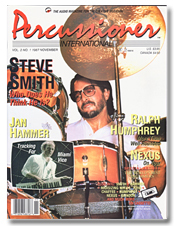

P.I. NOTES
When Percussioner International Audio Magazine was created three short years ago, we committed ourselves to helping Percussion and all the people related to it. Your response has been overwhelming and most gratifying. You told us what we do right and what we do wrong, but even more you told us PI was needed more often. Now I don't wish to relate what we have been through in these three years, but we promise that PI will be issued punctually and bi-monthly to serve your needs better.
To the Teachers: Five issues ago Percussioner International Audio Magazine intended to provide an intelligent audience with a foundation of information about percussion education and its related instruments. Our intentions were for you to acquire valuable instruction with which to further enrich and develop your knowledge in all facets of your profession, and to assist you in making basic and sometimes difficult decisions that will benefit you in your business.
To the Students: Think of Percussioner International as a base, a platform of instruction, from which you can gather the information needed to make those critical decisions about teachers and instruments used in your profession. It is like having a consultant on hand. Of course, it is impossible to taylor a magazine to meet everyone's needs, but it is our belief that PI is the only magazine that tries to fulfill that special need. We present information that will help you understand where music is headed, the technology that is behind or ahead of it, what is available really, what to look and ask for regarding the instruments you hear and see in the seminars. PI really cares about you and, most of all, your mind. You, most probably, will ask your music retailer about a new item, be it a book, instrument or technique, before it is even on the shelf or common knowledge.
To the Music Retailers: We combined the simplicity of an ordinary music magazine with the sophistication of high-tech, and sometimes back-to-basic, music info of the world, so you can count on PI to grow with your business as fast and as far as you can take it. In all honesty, the information offered through Percussioner International is first rate. That is why you reorder PI. We keep the wheel of education turning and progressing forward.
Please, give us your feedback. Let us know how we can improve PI for the years to come. Thank you.
--Sal Sofia
Percussioner International Vol 1, Number 4. P.I. INTERVIEWS Steve Smith, Nexus, Ralph Humphrey, Jan Hammer. P.I. GUEST SPEAKER Jan Hammer. P.I. SEMINARS John Beck, Efrain Toro, Terry Silverlight, Gary Chaffee, Ralph Humphrey, Jan Hammer, George Marsh, Emil Richards, Ed DiCapua and James Guarnieri, Nexus, Ed Saindon. P.I. GIVING IT TO YOU STRAIGHT Ralph LaFemina. P.I. ON THE OTHER SIDE OF THE TRACK Steve Smith. P.I. THIRTEEN QUESTIONS P.I. STRETCHING OUT The World Drum Festival. .


NOTES
TO BE POSTED.
--Sal Sofia